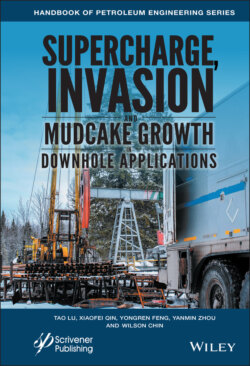Читать книгу Supercharge, Invasion, and Mudcake Growth in Downhole Applications - Группа авторов - Страница 12
1
Pressure Transient Analysis and Sampling in Formation Testing
ОглавлениеThe formation tester is a well logging instrument with extendable pad nozzles which, when pressed against the borehole sandface, extracts in situ formation fluids for delivery to the surface for chemical examination. This process characterizes its fluid “sampling” function. By-products of this operation are pressure transient histories, which can be interrogated using Darcy math models for fluid and formation properties such as permeability, mobility, anisotropy, compressibility and pore pressure. This is referred to as “pressure transient analysis,” or simply, “PTA.” Both can be conducted as wireline or Measurement While Drilling, or “MWD,” applications, where these operations now represent invaluable elements of the standard well logging suite.
Pressure transient analysis challenges. While collecting and transporting fluids is relatively straightforward, e.g., storing samples in secure vessels that maintain downhole conditions, the PTA process poses a greater design challenge. A well designed tool often begins with a good understanding of the environment, plus physics coupled with sound experience in mathematical modeling. Some ideas are obvious. For example, a single “source” or “sink” probe, serving both pumping and pressure observation functions, will at most provide the “spherical permeability” kh2/3kv/1/3, where kh and kv are horizontal and vertical permeabilities. Thus, “single probe” tools, while mechanically simple, will offer fewer logging advantages than “dual probe” or “multiprobe tools” which provide much greater formation evaluation information.
Figure 1.1. Drawdown-buildup pressure response with dynamic pumping action and flowline.
But how are probe arrays configured and placed for optimal effect? Figures 1.1 and 1.2 illustrate the operation of a single probe tool that withdraws fluid and then stops, creating the expected “drawdown and buildup” shown. If a second probe is desired, should it be placed an axial distance apart but along the same azimuth? Or azimuthally apart, at 180° away along the borehole circumference? What about a “drawdown only” pumpout? Or perhaps, have the pump oscillate sinusoidally in place, thus mimicking the AC transmissions of an electromagnetic logging tool? How many probes are best? What are their flow areas? Do answers to these questions depend on fluid and formation properties?
Figure 1.2. Downhole, surface and logging truck operations.
Background development. The present book addresses these questions for “source” or “sink models” of the pumping nozzle, these terms referring to ideal representations of the flow where borehole and pad geometry are described using mathematically small closed surfaces. The recent books due to Chin et al. (2014) or Formation Testing: Pressure Transient and Contamination Analysis, Chin et al. (2015) or Formation Testing: Low Mobility Pressure Transient Analysis, and Chin (2019) or Formation Testing: Supercharge, Pressure Testing and Contamination Models, published by John Wiley & Sons, contain complete math derivations and detailed validations. However, the rapid pace of recent development suggests a separate volume in Wiley’s Handbook of Petroleum Engineering Series, focused on the main ideas behind the recent works. These ideas are essential as they are also used in the design of newer COSL formation testing tools as well as in interpretation software now available to the petroleum industry. What engineers lack, at present, are job planning and PTA tools both useful at the rigsite and at engineers’ desktops. It is our purpose to support this pressing need.
Figure 1.3. Recent formation testing book publications.
